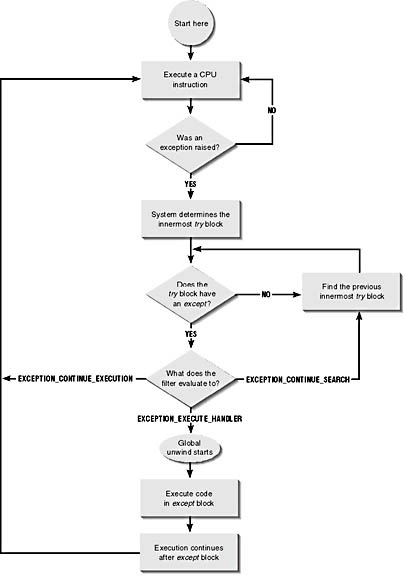Understanding Exception Filters and Exception Handlers by Example
Unlike termination handlers (discussed in the previous chapter), exception filters and exception handlers are executed directly by the operating system—the compiler has little to do with evaluating exception filters or executing exception handlers. The next several sections illustrate the normal execution of try-except blocks, explain how and why the operating system evaluates exception filters, and show the circumstances under which the operating system executes the code inside an exception handler.
Funcmeister1
Here's a more concrete coding example of a try-except block:
DWORD Funcmeister1() { DWORD dwTemp; // 1. Do any processing here. |
In the Funcmeister1 try block, we simply move a 0 into the dwTemp variable. This operation will never cause an exception to be raised, so the code inside the except block will never execute. Note this difference from try-finally behavior. After dwTemp is set to 0, the next instruction to execute is the return statement.
Although return, goto, continue, and break statements are strongly discouraged in the try block of a termination handler, no speed or code-size penalty is associated with using these statements inside the try block of an exception handler. Such a statement in the try block associated with an except block won't incur the overhead of a local unwind.
Funcmeister2
Let's modify the function and see what happens:
DWORD Funcmeister2() { DWORD dwTemp = 0; // 1. Do any processing here. |
In Funcmeister2, an instruction inside the try block calls for the attempt to divide 5 by 0. The CPU will catch this event and raise a hardware exception. When this exception is raised, the system will locate the beginning of the except block and evaluate the exception filter expression, an expression that must evaluate to one of the following three identifiers as defined in the Windows' Excpt.h file.
| Identifier | Defined As |
|---|---|
| EXCEPTION_EXECUTE_HANDLER | 1 |
| EXCEPTION_CONTINUE_SEARCH | 0 |
| EXCEPTION_CONTINUE_EXECUTION | -1 |
In the next few sections, we'll discuss how each of these identifiers alters the thread's execution. While reading these sections, you can refer to Figure 24-1, which summarizes how the system processes an exception.

Figure 24-1. How the system processes an exception
EAN: 2147483647
Pages: 193
- Chapter III Two Models of Online Patronage: Why Do Consumers Shop on the Internet?
- Chapter IV How Consumers Think About Interactive Aspects of Web Advertising
- Chapter VIII Personalization Systems and Their Deployment as Web Site Interface Design Decisions
- Chapter X Converting Browsers to Buyers: Key Considerations in Designing Business-to-Consumer Web Sites
- Chapter XVIII Web Systems Design, Litigation, and Online Consumer Behavior